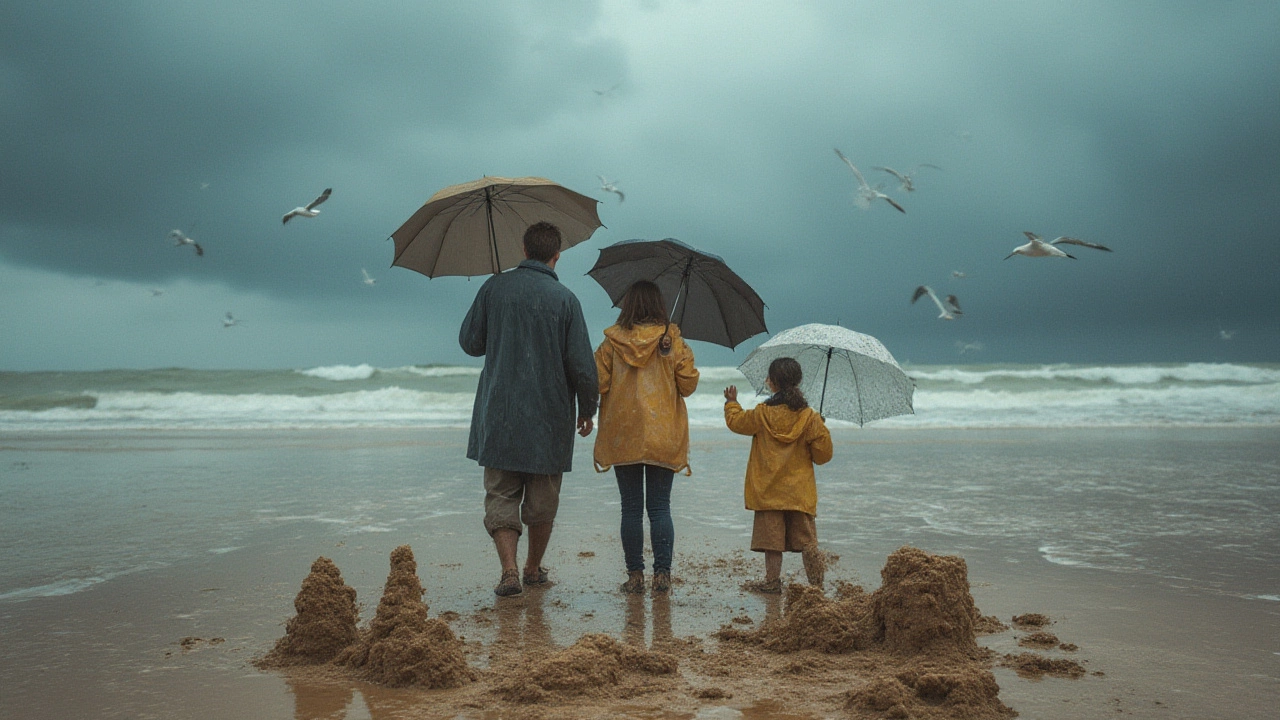UK Holiday Disadvantages: Why Staycations Aren't Always Perfect
 Jul, 17 2025
Jul, 17 2025
Picture it: you’ve just finished weeks of stressful work, craving blue skies and a fresh adventure, so you grab your suitcase and book a break right here in the UK. But wait—a muddy field, drizzle, and hours stuck on the motorway? Not quite the storybook escape. Plenty of us love a local getaway; the UK is famous for rolling hills, historic villages, and quirky seaside towns. But let’s get real—the grass isn’t always greener (sometimes, it’s just wetter). Here’s a look at what’s not so dreamy about staycations in Britain and what you’ll want to weigh up before you say no to that Spanish sunshine.
The British Weather: Soggy Shoes and Packed Umbrellas
Let’s cut straight to it: British weather has a knack for gatecrashing your well-laid holiday plans. Planning a BBQ on the Cornish coast? That raincloud didn’t get the memo. From May to September, the UK can swing from ‘beach ready’ to ‘bring a brolly’ in a blink. According to the Met Office, the UK averages 133 rainy days a year, and summer heatwaves still come with a side of downpour. If you’ve ever tried wild camping in Yorkshire or spent half your trip sheltering in a coffee shop while the wind howls outside, you’ll know the drill.
This isn’t just a mild inconvenience—it shapes your entire holiday. Packed beaches become ghost towns, scenic outdoor plans turn into soggy board games in holiday lets, and spontaneous walks end up as races to the nearest pub. There’s a reason British people talk about the weather so much: it’s unpredictable and loves to surprise. And let’s not forget: it’s cold. Even in July, the average UK high rarely tops 22°C (71°F). If you’re desperate for guaranteed sun, UK holidays are a gamble. Beach goers, swimmers, and fans of poolside lounging are often left longing for those Mediterranean rays.
If you do choose to take on the British climate, here are a couple of essential tips: pack layers rather than one big coat (so you can peel off once the sun pokes out for its 10 minutes of glory). Waterproof shoes are a game-changer, especially if you’re exploring the Lake District or Scottish Highlands, and always scout for indoor alternatives—think leisure centres, art galleries, or historic estates nearby. A portable rain poncho might look ridiculous, but when the heavens open, you’ll be everyone’s hero.
Costs That Creep Up on You: Is it Really Cheaper to Stay Home?
There’s this persistent myth that UK holidays are wallet-friendly. Sometimes true—after all, you’re skipping flights abroad. But as anyone who’s tried booking a two-bed cottage in Cornwall in August will tell you, the British staycation can be brutally expensive. Since 2020, domestic holiday prices have soared by up to 35%, according to a Which? Travel survey, thanks to a mix of increased demand and fewer overseas options. That little seaside B&B can sometimes cost more than a boutique hotel in Prague or a week’s Airbnb in Portugal.
Accommodation is just the start. Add parking fees (which, in cities like Brighton, make London look like a bargain), restaurant markups, and skyrocketing train fares. A family of four can easily spend more on UK rail tickets than on flights to Spain. Remember, a 2024 LNER survey found peak season London–Edinburgh returns surpass £300 per person. Car hire, petrol, dog boarding, entrance tickets, and all those little extras for ‘quirky’ indoor attractions pile up fast. The UK doesn’t exactly do all-inclusives, so you’ll likely shell out for every meal, day trip, and rainy day diversion. Even once you arrive, basic groceries can be pricy—especially in popular tourist pockets or on remote islands.
If you want to keep costs from spiraling, plan bookings early (months in advance for the best rates), avoid travelling during school holidays, and look for last-minute deals from trusted sites. Self-catering helps, but British supermarkets in peak resorts don’t do budget baskets (the same salad bag can cost twice what it does in your hometown). Draw up a realistic budget before you confirm anything—factor in transport, meals, and extras, then add 20% as a buffer. It won’t feel cheap, but it does save shock at checkout.

Crowds, Traffic Jams, and FOMO: The Rush Is Real
Maybe you thought escaping abroad would avoid the masses. Sadly, summer in the UK brings its own kind of chaos. Ever tried finding a parking spot in the Lake District on a sunny Saturday? Or joining a queue for fish and chips in Whitby in August? You won’t be alone—Office for National Statistics reports over 50 million overnight domestic trips taken across the UK in summer 2023. Brits staycating means beaches, bridges, and beauty spots fill up in the blink of an eye.
Traffic, especially on motorways heading to Cornwall, Devon, or the Scottish Highlands, can kill the joy before your break begins. The RAC warned in July 2024 that holiday jams on key routes like the M5 and M6 can double drive times over summer weekends. Trains aren’t necessarily better—operators often add carriages, but peak-time carriages can feel like rush hour in Tokyo. If you’re aiming for a bit of peace, it’s tricky; hidden gems get blabbed about on social media and TikTok, and suddenly half of Instagram wants to wild swim at your secret waterfall.
No one wants to begin their break standing in a two-hour queue for ice cream. But here’s the thing: with some planning, you can dodge the rush. Choose off-peak travel dates if you can, hit attractions as soon as they open, and look for up-and-coming destinations instead of classic hotspots. Northumberland, East Yorkshire, or mid-Wales can be just as scenic as the more crowded Cornish coast but far quieter. Consider booking self-guided experiences or lesser-known walking trails for some real breathing space. And always, always allow for delays—the earlier you leave, the less likely you’ll end the day stuck on a slip road outside Exeter.
It’s Good, but Is It Different? The Variety Problem
There’s a lot to love about UK break: our history runs deep, and endless landscapes roll from moors to mountains, but there’s a catch. After your third cream tea in a row or second stately home tour, a sense of déjà vu can creep in. Many domestic trips, especially in smaller towns, offer pretty similar menus of activities: countryside walks, tearoom visits, and trips to small museums.
If you’ve got kids, keeping everyone entertained gets tricky, especially if it rains. British seaside amusements, arcades, and donkey rides are fun—but nostalgia can only stretch so far. Compared to a city break in Rome or a week on the Croatian coast, local holidays can sometimes feel limited. You might see incredible cliffs and castles, but you won’t get that total culture shift that a trip abroad gives. Food-wise, the UK is improving beyond soggy chips, but quality varies—restaurants in tourist spots often cater for mass tastes, and it’s not impossible to pay £10 for a disappointing sandwich in a place you queued for.
This isn’t to say you can’t have magical UK breaks. But if you love trying new cuisines, soaking up foreign languages, or heading off on totally unfamiliar adventures, you may hunger for more novelty than the typical staycation serves up. A top tip? Mix things up: book a guided wild food foraging walk, try paddle boarding somewhere unexpected, or find a local festival. Just don’t expect every UK break to deliver the buzz of a city escape or the restfulness of a laid-back Mediterranean beach.
| Disadvantage | Details | Tip to Minimise |
|---|---|---|
| Unpredictable weather | 133 rainy days/year; average July high 22°C | Pack layers and waterproofs; plan indoor options |
| High costs | Prices up 35% since 2020; city parking & train fares expensive | Book early, compare deals, self-cater where possible |
| Crowded destinations | 50+ million overnight trips in 2023; traffic jams common | Travel off-peak; try less-known spots; leave early |
| Limited new experiences | Often similar food, activities, and sights | Seek out new areas or activities; check regional festivals |
For every misty mountain and windblown pier, there’s an unglamorous truth lurking just behind: UK holidays aren’t always a bargain, they’re not reliably restful, and you might need to bring your sense of humour along with your walking boots. But with smart planning, realistic expectations, and maybe a little luck with the weather, you can still make the most of it—or, if you fancy, put those savings toward a sun-soaked break next time.
